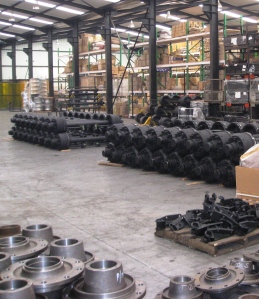I am preparing for a presentation at a conference in May about development programmes shifting from a sectoral to a regional or local perspective. This got me thinking about these shifts in focus and why they appear.
In economic development, it is often necessary to choose whether to intervene at a sectoral level, or whether it would be better to take a locational or geographic approach. In my experience I have learned that when you start with the one, i.e. with a specific sector or value chain, you often end up with the other, i.e. supporting specialization or addressing specific issues in a certain location. But this is of little consolation to managers of development programmes and Local Economic Development units who are then typically measured by the wrong indicators or that have different incentives due to the design of their programme or institutional mandate.
During my MBA, the Professor in Organisational Development introduced us to a really elegant tool to assess whether a tension or conflict between different approaches could really be addressed. He introduced us to Polarity Management, a simple instrument developed by Johnson (1992). According to Johnson, many problems that we face today are not really problems to be solved, but polarities to be managed. Johnson argues that we can continually try to solve these problems by shifting our strategies to another mode where we perceive lots of benefits. The trouble is that after a while of some negative aspects emerge, and suddenly the benefits of the other strategy seems to be more attractive.
Polarity management is an instrument that can be used by change management practitioners to understand these polarities and to manage them. It implies that perhaps these different strategies even depend on each other, like breathing in versus breathing out. We need both, even if they have very different objectives, benefits and downsides. This means that the strengths and the weaknesses of alternatives must be understood, and then managed.
In development we have many polarities, for example wealth creation versus poverty reduction, or designed interventions versus enabling evolution, project versus process, top down versus bottom up, and many others. It is very expensive and even risky to shift between these, and an organisations current expertise, instruments and orientation may find it very hard to make these shifts effectively. But some try and some even manage to do this.
This post is for those organisations that are undecided about their strategy and their focus.. A key question then is how do we manage these alternatives, especially if we want the best of both worlds?
There are 3 steps to better understand a polarity:
- Fill in the headings of the two polarities in the matrix
- Capture the strengths and the weaknesses of both in the columns
- Determine if there is a movement of preference between the polaries, meaning that when the negative consequences of a particular strategy becomes too much, strategy is shifted to the other approach for its apparent strengths. Then over time, the negatives start to weight in on the positives, resulting in a shift to the other approach.
Below I have quickly written down some of the positives and negatives of both approaches. This is an incomplete list but I think it is sufficient to illustrate the point. The PDF of the graphic below can be found here. For those that cannot read so small, the bottom line is this: there are pluses and minuses to both paradigms. Under each strategy, the benefits of the one approach may outweigh the negatives of that approach, but be aware, these weights are changing and after a while the other strategy may become more desirable!
The third step in understanding the polarity is to look at whether there is a shift between these polarities. From my experience working in a dozen or so developing countries, development programmes are either designed to be sectoral or geographic, with very few programmes designed to do both. From a local perspective, institutions and programmes are designed and resourced to either be targeted at specific industries and sectors, or they have a locational focus. It is very hard for programmes and institutions to build a case that a strategic shift to the other paradigm may be needed, even if for only a part of the resources to be dedicated to the other approach. This typically happens when the negatives of a current path starts to outweigh the positives, and the benefits of the other approach increasingly looks appealing. The danger is that a compromise is reached, instead of a synergy being developed.
From a Local Economic Development perspective, growing the technical capability to pursue both strategies simultaneously is important. This does not imply that both are equally important at any given time, as both these approaches have different timescales, resource requirements, and objectives. For example, it would be unwise to leave a dominant sector to its own devices in order to focus on emerging enterprises. At the same time, focusing on the issues of a dominant sector might distract attention from purposefully promoting emergence, diversification and economic resilience. Yet, many programmes and organisations are forced to choose, often too early when not enough is understood about the dynamics of the place or the industries. For me the worst reason to choose an particular approach is because some or other decision maker has attended a training course or conference, or because a particular approach is deemed “best practice”. In fact, most of my time is spent trying to help leaders and decision makers get out of a mess because their programme or institutions was designed based on some ideology or “solution” without enough attention being given to the requirements, trajectories and complexity of the specific context.
For national governments and international development programmes there seems to be a continuous shift between these two. Almost like a flip-flopping from one to the other. I think that the shifts are counter productive, as the learning from the previous shifts are often lost. If I just think back over my 16 year career how often the value chain or sub sector approaches or alternatively cluster and Local Economic Development have become fashionable again and then losing its appeal after a short time.
My conclusion is that while there is a tension between these approaches, the shifting between the strategies are not taking place at an institutional or programmatic level. Decisions about these strategies are made at higher levels of government and development cooperation with little regard for the challenges faced at sub national level in developing countries to build and grow “the right” institutions that can ensure long term economic evolution and development.
At the implementation level, regional development programmes should do both:
- Sectoral programmes that ignores the impact of their sector on the geographic areas they are working in are most likely creating negative externalities, even with the best intentions in mind and even when they achieve their objectives of inclusiveness, job creation or export promotion. The negative externalities could be about the environment (mono economy, mono culture), or about increasing the coordination cost of every economic activity not related to the priority sectors (institutional or locational lock-in to particular paths and trajectories). Sectoral programmes that ignore opportunities for regional nuances to develop in their targeted sectors miss important opportunities to enable diversification and emergence of unique regional capabilities.
- Location development programmes that do not collaborate with other locations to build sufficient scale in particular sectors to justify investing in particular regionally significant institutions will forever remain trapped in low value add, or perpetual dependence on the priorities and mood shifts of national governments. While trying to help every kind of economic activity in a region, you have to at some point also start promoting specific industries and sectors in order to try and reach some leverage or scale.
But most importantly, the economic activity, available institutional capabilities and the regional context prescribes where to start. And when you have started down a chosen path, be sensitive to when it may be necessary to foster additional organisational or collaborate with other institutions with different more adequate capabilities to enable the benefits of the other strategy to be leveraged. A key challenge in developing countries is that we do not have a rich layer of supporting institutions pursuing different strategies. Everyone seem to be trying more or less the same approaches, or chasing the same politically set targets.
In our capacity building sessions in Mesopartner we always elaborate on the importance of value chains and sectors to Local Economic Development practitioners, and the importance of regional competence development for value chain and sector development specialists. Actually, the process of diagnosing industries and regions are very similiar, even if you would give slightly more attention to different issues and perspectives.
In the end, from a bottom up perspective, supporting specific industries allows for scale and focused public investment, but caution must be taken to not create path dependence or institutional lock in. At the same time, a regional approach is critical as it allows for emergence of new kinds of economic activity and for diversity to emerge. I think we need to development of synergies for both, but it depends on the context what your priority should be. Simply being aware that there are pluses and negatives to either strategy is already a good start! This makes it much easier to collaborate with other organisations and programmes that have different objectives and priorities.
Now I have some questions to my readers:
- What is your current approach in your programme or organisation? Sectoral or locational?
- Have you even been through a shift from the one to the other in your programme, or do you cater for both?
- How did making the shift work out? Did you have the networks, resources and expertise to make this shift?
- What would you do differently next time?
- Please share your thoughts by commenting below, or send me an email if I can paste your comments unanimously if you are afraid to upset somebody higher up the chain.
References:
JOHNSON, B. 1992. Polarity management : identifying and managing unsolvable problems. Amherst, Mass: HRD Press.






